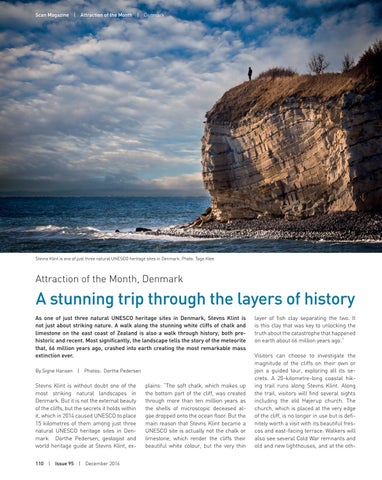Scan Magazine | Attraction of the Month | Denmark
Stevns Klint is one of just three natural UNESCO heritage sites in Denmark. Photo: Tage Klee.
Attraction of the Month, Denmark
A stunning trip through the layers of history As one of just three natural UNESCO heritage sites in Denmark, Stevns Klint is not just about striking nature. A walk along the stunning white cliffs of chalk and limestone on the east coast of Zealand is also a walk through history, both prehistoric and recent. Most significantly, the landscape tells the story of the meteorite that, 66 million years ago, crashed into earth creating the most remarkable mass extinction ever. By Signe Hansen | Photos: Dorthe Pedersen
Stevns Klint is without doubt one of the most striking natural landscapes in Denmark. But it is not the external beauty of the cliffs, but the secrets it holds within it, which in 2014 caused UNESCO to place 15 kilometres of them among just three natural UNESCO heritage sites in Denmark. Dorthe Pedersen, geologist and world heritage guide at Stevns Klint, ex110 | Issue 95 | December 2016
plains: “The soft chalk, which makes up the bottom part of the cliff, was created through more than ten million years as the shells of microscopic deceased algae dropped onto the ocean floor. But the main reason that Stevns Klint became a UNESCO site is actually not the chalk or limestone, which render the cliffs their beautiful white colour, but the very thin
layer of fish clay separating the two. It is this clay that was key to unlocking the truth about the catastrophe that happened on earth about 66 million years ago.” Visitors can choose to investigate the magnitude of the cliffs on their own or join a guided tour, exploring all its secrets. A 20-kilometre-long coastal hiking trail runs along Stevns Klint. Along the trail, visitors will find several sights including the old Højerup church. The church, which is placed at the very edge of the cliff, is no longer in use but is definitely worth a visit with its beautiful frescos and east-facing terrace. Walkers will also see several Cold War remnants and old and new lighthouses, and at the oth-
